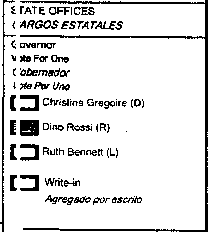

VotersUnite.Org
is NOT!
associated with
votersunite.com
| Hart InterCivic Optical-Scan Has A Weak Spot By John Gideon, Information Manager for VotersUnite.Org and VoteTrustUSA 05 July 2005
Yakima County uses Hart InterCivic eSlate central count optical scan and DRE systems. The optical scan system uses a Kodak scanner that scans the ballots, and then the ballot images are analyzed by the eSlate Ballot Now software and tallied. Unfortunately, Yakima County made the decision that they would not re-scan their ballots for the machine recount. The decision was made at the county level, at least, and possibly at the state level, that it would be alright to simply re-analyze the ballot images previously generated by the scanner. However, fortunately for the voters but unfortunately for Yakima County and Hart InterCivic, the machine recount was followed by a hand-recount requested by the candidate who came in second in the recount. In one Yakima precinct, the hand recount resulted in 24 new votes that had previously gone uncounted. This is 24 votes representing 24 voters from Precinct 3301 who had lost their votes for Governor until the hand count of the original ballots found those votes. How did this happen? Thatís the question that the county asked Hart InterCivic. An email received in response to an Open Records Request to Yakima County answers that question. On June 15, 2005, Travis Harrell a manager at Hart InterCivic reported the results of an investigation his company had been carrying out. The reported reason for the 24 uncounted ballots is that some foreign material, i.e. dirt or a small piece of paper, was deposited on the screen of the scanner during the scanning of the ballots. This foreign material caused a white line to run down the right hand column of votes on all 24 of those ballots. Part of an actual ballot image is shown below.
Note that there were four other races in that same damaged column, so the votes of 24 voters in four other races were permanently lost. See page 4 of the email message from Mr. Harrell: Mr. Harrell reported the following:
The problem is also indicative of a problem with elections procedures. In this case, someone approved the use of the originally scanned images in the recount, even though the recount was clearly supposed to be a complete machine recount of all ballots cast on optical scan and punch card systems. This decision allowed those 24 votes to remain uncounted a second time. How could the county have known that there was a problem even if there was no recount? The precinct in discussion was precinct 3301. A total of 512 ballots were cast via absentee voting and counted by the optical-scan system. A total of 31 undervotes were reported in that precinct. Undervotes are not out of the ordinary. In fact, in Yakima County, almost all precincts had some undervotes in the gubernatorial race. However, while the average gubernatorial undervote rate for all precincts was 1.6%, Precinct 3301 reported 6% undervotes. This should have been a red-flag. Hand counting those 31 "undervotes" caused by a speck of foreign material revealed only 7 true undervotes a 1.3% percentage that is comparable to the rest of the county. So what needs to be done in the future so this never happens again? First, the rules for machine recounts must be spelled out and followed. Short-cuts only lead to problems and should never be taken. Second, elections officials must be aware of anomalies. They must look for red-flags and question them. Anomalies can indicate lost votes. Third, election officials should examine all Damaged Contests rather than allowing the software to "autoresolve" such problems without human oversight. Fourth, election officials should consider setting the software to detect a vote when less than 90% of the target box is filled in. As the ballot image demonstrates, a significantly smaller percentage can be filled in and still indicate a vote for the selected candidate. And finally, if the hand recount had not been done, no one would ever have known that a speck of dirt could cause ballots not to be counted. A percentage of all ballots counted by the Hart InterCivic optical scan machines must be audited every election. The audit must be to hand count the original, voter marked paper ballots and compare the results of the hand count to the machine results. Without this minimal check on the accuracy of the machines, we will never know whether votes are being discarded. [Thanks to Paul Lehto for requesting the records that brought this information to light and for calling it to our attention.]
If the public or election official has any question over the results of an election, a hand count of the optical paper ballot provides the truth. |

2004 to 2009
Copyright © 2004-2010 VotersUnite!



